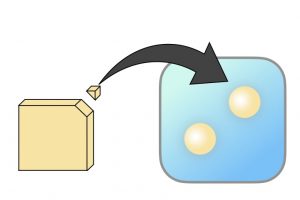Ultrasonic Analysis of Polyurethane Nano-emulsion (JJAP)
We are pleased to announce that our English peer-reviewed paper on aqueous polyurethane nanoemulsions submitted to the Japanese Journal of Applied Physics (Special Issues) dated January 25, 2024 has been accepted for publication.
Polyurethanes are often used as coating materials, but in order to reduce the environmental impact, waterborne polyurethane nanoemulsions (WPU) without organic solvents are being actively investigated. In fact, the glass transition temperature of the former is below room temperature, while the latter is above room temperature. Why are the properties so different when the exact same polymer is simply made into a sheet?

The ultrasonic spectroscopy method can be used to evaluate the elasticity of particles dispersed in water. For example, if there is a polystyrene plate, the elastic modulus of the polystyrene plate can be determined from the ultrasonic waves transmitted through the plate. If there are polystyrene particles dispersed in water, the elastic modulus of the polystyrene can be determined while the particles are in the same condition. In this study, we found at the particle level that the elasticity of WPU nanoemulsions prepared by the phase inversion method is different from that of WPU obtained by drying acetone solutions. This is related to the ionic groups introduced by the polyurethane to adapt to water and build the nanostructure.

For more information, please see the paper.
